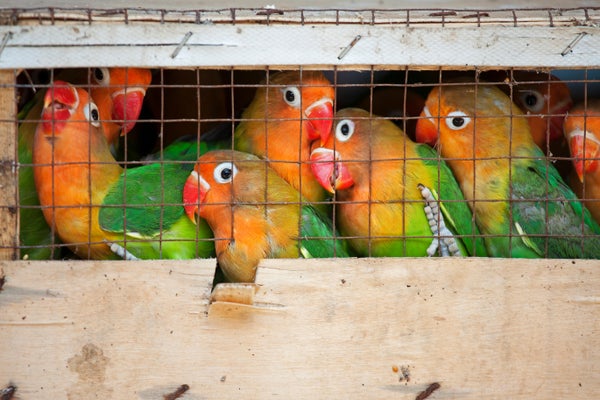Humans have long been successful predators, thanks to our advanced cognition, tools and technology. And now a new study examining human predation’s influence on nature reveals some fresh insights, such as the fact that we capture even more terrestrial vertebrate species for medicine, the exotic pet trade and other uses than we do for food—setting us apart as a highly unusual kind of predator.
Study author Chris Darimont, an ecologist who is also an avid hunter and angler, says he first thought to look at patterns of human predation after he heard fellow hunters disparagingly calling wolves and bears “goddamn predators.”
“Personally, I thought that was strange,” given that humans are also predators, Darimont says. Though the ecological impacts of predators such as wolves, bears and orcas are well studied (Darimont himself has studied wolves for decades), modern human predator ecology has received much less attention. So Darimont, who works at the University of Victoria in British Columbia and the nonprofit Raincoast Conservation Foundation, assembled colleagues in Brazil, Canada, the U.S. and the U.K. to investigate humans’ predatory role. The researchers explored how our prey choices vary from place to place and how our predatory motivations—from the exotic pet trade to sport hunting and fishing—affect species’ extinction risk.
Predation usually refers to catching and killing prey for food. But for the purposes of their study, Darimont and his team defined it as “any use that removes individuals from wild populations, lethally or otherwise, via processes ranging from local subsistence to global commercial harvesting and trade.” In the study, published on June 29 in Communications Biology, the team analyzed data from the International Union for Conservation of Nature (IUCN) that categorize how a vast range of species are used—for example, as human or animal food or in sport hunting or medicine. For the approximately 47,000 vertebrate species examined, Darimont and his colleagues also checked on which types of human use were rated by the IUCN as a serious threat. They then used this information to determine the degree to which a species was endangered by human predation.
The team’s analysis revealed that humans target some 15,000 vertebrate species, amounting to one third of all such species on Earth. That’s anywhere from five to 300 times the number of species targeted by other predators with a wide geographical range, such as sharks, birds of prey and mammalian carnivores. Our ecological impact, the researchers found, is 1,300 times larger than that of comparable predators.
When they assessed species by habitat, they found that humans have the greatest impact in the ocean. People exploit 43 percent of the marine species examined in the study (mostly fish). We additionally use about 35 percent of assessed freshwater species and 26 percent of terrestrial ones. Taxonomically, birds were the hardest-hit group, with 46 percent of evaluated species used in some way—many captured for the pet trade. Ray-finned fishes (such as Atlantic bluefin tuna and sockeye salmon) were the next most affected taxonomic group, with 42 percent of species used, many for food.
But overall the new research found that only about half of the species humans prey on end up being eaten. “Food use wasn’t as major a use as we expected,” says study co-author Rob Cooke, an ecologist at the U.K. Center for Ecology and Hydrology. “The other half was these diverse uses for clothes and animal feed and poison and manufacturing chemicals.” To Cooke and Darimont, the extent to which animals were taken from the wild to become pets was the most surprising finding. Much of this is for the captive bird trade, but there is also considerable trade in reptiles and in fish for aquariums.
Conservation biologist Nuria Selva of the Institute of Nature Conservation at the Polish Academy of Sciences, who was not involved in the study, was also struck by the prevalence of the pet trade. This is not a primary need,” she says, “so this, for me, was a bit shocking.”
Almost 40 percent of species used by humans are threatened by this diverse range of human exploitation.
The research also highlighted that the prey humans target is very specific, not a random selection of what’s available. That matters because different species do different jobs in their respective ecosystems, and some are more important than others in terms of their ecological role, Cooke says. “We’re more likely to do damage to species that serve some pretty unique roles in ecosystems,” Darimont says. He notes that such a species’ combinations of traits might not be well represented by other animals, making that species functionally irreplaceable. Cooke gives the example of seed-dispersing fruit eaters that are critical to forest regeneration, such as the Helmeted Hornbill in Southeast Asia. Illegal wildlife traders frequently target this bird for its beak, which is carved into collectibles.
University of British Columbia ecologist Kaitlyn Gaynor, who was not involved in the new research, says its findings are clear evidence that humans are novel predators. If anything, she says, the study’s conclusions are conservative. “We of course don’t have perfect information on every single species that people are using,” she says.
Humans are “the Swiss Army knife of predators,” Darimont says. For eons we behaved like many other predators that capture prey for energy and nutrients, he says. Now we more commonly remove terrestrial animals from the wild for nonfood reasons. “To me, that’s extraordinary,” Darimont says, adding that we’re a materially oriented culture. “We like stuff.”


